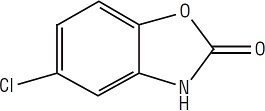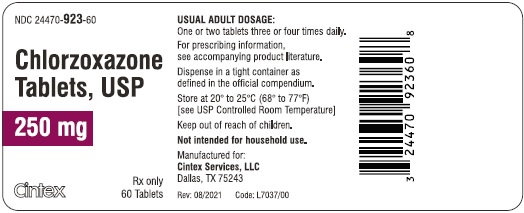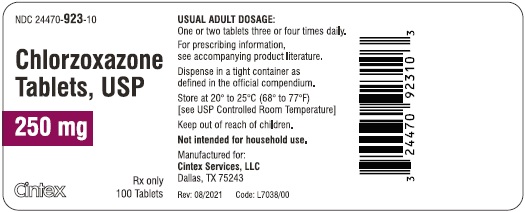CHLORZOXAZONE Dailymed
Generic: chlorzoxazone is used for the treatment of Liver Diseases Muscle Cramp Muscle Rigidity Myositis Pain Spasm
Go PRO for all pill images
For Painful Musculoskeletal Conditions
Description
Each tablet contains:
Chlorzoxazone* .................................. 250 mg
* 5-Chloro-2-benzoxazolinone
Structural Formula:

Molecular Formula: C 7H 4CINO 2
Molecular Weight: 169.57
Chlorzoxazone, USP is a white or practically white, practically odorless, crystalline powder. Chlorzoxazone is slightly soluble in water; sparingly soluble in alcohol, in isopropyl alcohol, and in methanol; soluble in solutions of alkali hydroxides and ammonia.
Inactive ingredients: colloidal silicon dioxide, croscarmellose sodium, docusate sodium, sodium benzoate, lactose monohydrate, magnesium stearate and microcrystalline cellulose.
Meets USP Dissolution Test 4
Clinical Pharmacology
Chlorzoxazone is a centrally-acting agent for painful musculoskeletal conditions. Data available from animal experiments as well as human study indicate that chlorzoxazone acts primarily at the level of the spinal cord and subcortical areas of the brain where it inhibits multisynaptic reflex arcs involved in producing and maintaining skeletal muscle spasm of varied etiology. The clinical result is a reduction of the skeletal muscle spasm with relief of pain and increased mobility of the involved muscles. Blood levels of chlorzoxazone can be detected in people during the first 30 minutes and peak levels may be reached, in the majority of the subjects, in about 1 to 2 hours after oral administration of chlorzoxazone. Chlorzoxazone is rapidly metabolized and is excreted in the urine, primarily in a conjugated form as the glucuronide. Less than one percent of a dose of chlorzoxazone is excreted unchanged in the urine in 24 hours.
Indications And Usage
Chlorzoxazone is indicated as an adjunct to rest, physical therapy, and other measures for the relief of discomfort associated with acute, painful musculoskeletal conditions. The mode of action of this drug has not been clearly identified, but may be related to its sedative properties. Chlorzoxazone does not directly relax tense skeletal muscles in man.
Contraindications
Chlorzoxazone is contraindicated in patients with known intolerance to the drug.
Warnings
Serious (including fatal) hepatocellular toxicity has been reported rarely in patients receiving chlorzoxazone. The mechanism is unknown but appears to be idiosyncratic and unpredictable. Factors predisposing patients to this rare event are not known. Patients should be instructed to report early signs and/or symptoms of hepatotoxicity such as fever, rash, anorexia, nausea, vomiting, fatigue, right upper quadrant pain, dark urine, or jaundice. Chlorzoxazone should be discontinued immediately and a physician consulted if any of these signs or symptoms develop. Chlorzoxazone use should also be discontinued if a patient develops abnormal liver enzymes (e.g., AST, ALT, alkaline phosphatase and bilirubin).
The concomitant use of alcohol or other central nervous system depressants may have an additive effect.
Usage in Pregnancy: The safe use of chlorzoxazone has not been established with respect to the possible adverse effects upon fetal development. Therefore, it should be used in women of childbearing potential only when, in the judgment of the physician, the potential benefits outweigh the possible risks.
Precautions
Chlorzoxazone should be used with caution in patients with known allergies or with a history of allergic reactions to drugs. If a sensitivity reaction occurs such as urticaria, redness, or itching of the skin, the drug should be stopped.
If any symptoms suggestive of liver dysfunction are observed, the drug should be discontinued.
Adverse Reactions
After extensive clinical use of chlorzoxazone-containing products, it is apparent that the product is well tolerated and seldom produces undesirable side effects. Occasional patients may develop gastrointestinal disturbances. It is possible in rare instances that chlorzoxazone may have been associated with gastrointestinal bleeding. Drowsiness, dizziness, lightheadedness, malaise, or overstimulation may be noted by an occasional patient. Rarely, allergic-type skin rashes, petechiae, or ecchymoses may develop during treatment. Angioneurotic edema or anaphylactic reactions are extremely rare. There is no evidence that the drug will cause renal damage. Rarely, a patient may note discoloration of the urine resulting from a phenolic metabolite of chlorzoxazone. This finding is of no known clinical significance.
Overdosage
Symptoms: Initially, gastrointestinal disturbances such as nausea, vomiting, or diarrhea together with drowsiness, dizziness, lightheadedness or headache may occur. Early in the course there may be malaise or sluggishness followed by marked loss of muscle tone, making voluntary movement impossible. The deep tendon reflexes may be decreased or absent. The sensorium remains intact, and there is no peripheral loss of sensation. Respiratory depression may occur with rapid, irregular respiration and intercostal and substernal retraction. The blood pressure is lowered, but shock has not been observed.
Treatment: Gastric lavage or induction of emesis should be carried out, followed by administration of activated charcoal. Thereafter, treatment is entirely supportive. If respirations are depressed, oxygen and artificial respiration should be employed and a patent airway assured by use of an oropharyngeal airway or endotracheal tube. Hypotension may be counteracted by use of dextran, plasma, concentrated albumin or a vasopressor agent such as norepinephrine. Cholinergic drugs or analeptic drugs are of no value and should not be used.
Dosage And Administration
Usual Adult Dosage: One tablet (250 mg) three or four times daily. Initial dosage for painful musculoskeletal conditions should be two tablets (500 mg) three or four times daily. If adequate response is not obtained with this dose, it may be increased to three tablets (750 mg) three or four times daily. As improvement occurs dosage can usually be reduced.
How Supplied
Chlorzoxazone tablets, USP, 250 mg are supplied as white, Capsule shaped tablet, debossed "A26" on one side and "250" on the other side.
They are available as:
Bottles of 60 with child-resistant closure: NDC 24470-923-60
Bottles of 100 with child-resistant closure: NDC 24470-923-10
Dispense contents with a child-resistant closure (as required) and in a tight container as defined in the USP/NF.
Store at 20° to 25°C (68° to 77°F) [see USP Controlled Room Temperature].
Manufactured for:
Cintex Services, LLC
Dallas, TX 75243
855-899-4237
Rev. 03/2023
L7039/01
Package Label.principal Display Panel
DISCLAIMER:
"This tool does not provide medical advice, and is for informational and educational purposes only, and is not a substitute for professional medical advice, treatment or diagnosis. Call your doctor to receive medical advice. If you think you may have a medical emergency, please dial 911."
"Do not rely on openFDA to make decisions regarding medical care. While we make every effort to ensure that data is accurate, you should assume all results are unvalidated. We may limit or otherwise restrict your access to the API in line with our Terms of Service."
"This product uses publicly available data from the U.S. National Library of Medicine (NLM), National Institutes of Health, Department of Health and Human Services; NLM is not responsible for the product and does not endorse or recommend this or any other product."
PillSync may earn a commission via links on our site




